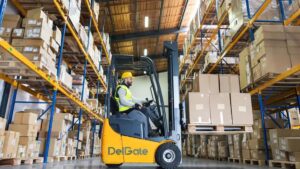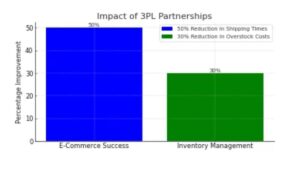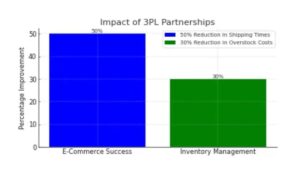BUSINESS
Next-Gen Innovations in Canadian Fulfillment

The Canadian fulfillment landscape is experiencing a wave of innovations that are revolutionizing how businesses manage their logistics. Fulfillment services in Canada are now more efficient, tech-driven, and customer-focused than ever before.
From state-of-the-art Canadian fulfillment centers to advanced pick & pack logistics, the industry is setting new standards. Innovations in Canadian fulfillment are enhancing speed and accuracy, ultimately transforming the customer experience and making it easier for companies to meet rising consumer demands.
The Evolution of Fulfillment Services in Canada
Canadian fulfillment centers have evolved significantly in recent years. The advent of new technologies and methodologies has allowed businesses to optimize their operations, reduce costs, and improve customer satisfaction. Fulfillment Canada is now at the forefront of these innovations, providing businesses with cutting-edge solutions that cater to the unique demands of the market.
Key Innovations in Canadian Fulfillment

- Robotics and Automation
The integration of robotics and automation in Canadian fulfillment centers has drastically improved efficiency. Automated systems handle tasks such as sorting, packaging, and shipping, reducing human error and increasing speed. This technology is particularly beneficial for pick & pack logistics, where precision and speed are crucial.
- Artificial Intelligence (AI)
AI is playing a significant role in optimizing fulfillment services in Canada. AI-driven systems can predict demand, manage inventory, and optimize the entire fulfillment process. This results in lower costs and better service for customers. Innovations in Canadian fulfillment also include automated warehousing solutions and advanced robotics, enhancing efficiency and accuracy in order processing.
- Advanced Inventory Management Systems
Modern inventory management systems are essential for efficient Canadian fulfillment. These systems use real-time data to track inventory levels, predict demand, and manage stock across multiple locations. This technology is vital for businesses that rely on fulfillment services solutions to ensure they have the right products in the right place at the right time.
Case Study: E-Commerce 3PL Success
A Toronto-based e-commerce company partnered with a local 3PL provider specializing in e-commerce, resulting in a 50% reduction in shipping times. This partnership not only enhanced customer satisfaction but also showcased the potential of innovations in Canadian fulfillment. The graphic chart below illustrates the impact of this partnership on shipping times:

Benefits of Modern Fulfillment Services in Canada
Improved Customer Satisfaction
Modern fulfillment services in Canada focus on speed and accuracy, which are critical factors for customer satisfaction. Faster shipping times and accurate order fulfillment lead to happier customers and increased loyalty.
Cost Efficiency
Innovative fulfillment services solutions help businesses reduce costs associated with inventory management, shipping, and handling. Automated systems and advanced inventory management reduce waste and optimize resource use.
Scalability
Canadian fulfillment centers equipped with the latest technology can easily scale operations to meet growing demands. This scalability is crucial for businesses looking to expand their reach and grow their customer base.
Case Study: Efficient Inventory Management
A Vancouver retailer partnered with a 3PL provider known for its robust inventory management systems. This partnership resulted in a 30% decrease in overstock costs, demonstrating the effectiveness of advanced inventory management in reducing waste and improving efficiency. The following graphic chart illustrates the cost savings achieved:

Fulfillment Services Solutions
- Pick & Pack Logistics
Pick & pack logistics are essential components of modern fulfillment services. This process involves selecting the right products (picking) and packing them for shipment. Advanced systems ensure accuracy and speed, reducing errors and improving customer satisfaction.
- Integrated Fulfillment Services

Integrated fulfillment services offer a comprehensive solution for businesses, covering everything from warehousing to shipping. These services provide a seamless experience for businesses, allowing them to focus on core activities while the fulfillment provider handles logistics.
- Customizable Solutions
Modern fulfillment centers in Canada offer customizable solutions to meet the unique needs of different businesses. Whether it’s specialized packaging, same-day shipping, or international fulfillment, these centers provide tailored services that enhance operational efficiency. Furthermore, innovations like automated inventory management systems and real-time tracking are transforming the landscape, ensuring a seamless experience for both businesses and their customers.
The Future of Fulfillment Services in Canada

The future of fulfillment services in Canada looks promising, with ongoing advancements in technology and methodology. Innovations such as drone delivery, blockchain for supply chain transparency, and IoT for real-time tracking are set to revolutionize the industry further. Canadian fulfillment centers are well-positioned to adopt these technologies and continue leading the way in efficient, customer-focused fulfillment services.
Conclusion
Innovations in Canadian fulfillment are transforming the logistics landscape, offering businesses advanced solutions to optimize their operations and enhance customer satisfaction. With cutting-edge technology and customized services, Canadian fulfillment centers are setting new standards in the industry. As the future unfolds, these innovations will continue to drive efficiency and growth, ensuring that businesses remain competitive in an increasingly dynamic market.
FAQs
What are the benefits of using fulfillment services in Canada?
Fulfillment services in Canada offer numerous benefits, including improved efficiency, cost savings, scalability, and enhanced customer satisfaction. These services leverage advanced technology to optimize logistics and ensure accurate, timely delivery of products.
How do Canadian fulfillment centers use technology to improve efficiency?
Canadian fulfillment centers use a range of technologies, including robotics, AI, and advanced inventory management systems. These technologies automate and optimize processes, reduce errors, and improve speed and accuracy in order fulfillment.
What is pick & pack logistics?
Pick & pack logistics involves selecting the right products (picking) and packing them for shipment. This process is critical for ensuring accurate and timely delivery, and advanced systems help improve efficiency and reduce errors.
How do modern inventory management systems benefit businesses?
Modern inventory management systems use real-time data to track inventory levels, predict demand, and manage stock across multiple locations. This helps businesses reduce overstock costs, avoid stockouts, and ensure they have the right products in the right place at the right time.
What is the role of AI in fulfillment services?
AI plays a significant role in optimizing fulfillment services by predicting demand, managing inventory, and streamlining processes. AI-driven systems help reduce costs and improve service by making more accurate predictions and optimizing resource use.
How can businesses benefit from integrated fulfillment services?
Integrated fulfillment services offer a comprehensive solution that covers warehousing, picking and packing, and shipping. This allows businesses to focus on their core activities while the fulfillment provider handles logistics, resulting in improved efficiency and customer satisfaction.
BUSINESS
The Power of Peace of Mind: Why Insurance Is an Investment, Not an Expense

Understanding Insurance as an Investment
Understanding insurance as an investment means recognizing that certain policies serve a dual purpose: offering financial protection and building long-term value. Unlike savings accounts, these policies create a safety net and accumulate cash value, like life insurance growing through interest or dividends, providing coverage and wealth buildup. Viewing insurance this way helps individuals choose policies aligned with their financial goals and risk tolerance. Even standard policies, such as auto insurance, contribute to financial planning by covering damages and liabilities, preventing major expenses that could affect budgets or investments. Recognizing insurance’s dual role as protection and potential investment allows for better financial stability and peace of mind.
Major Types of Insurance and Their Benefits
Each insurance type serves a specific purpose. Health insurance covers unexpected illnesses, providing lifesaving care when needed. Property and homeowner’s insurance help rebuild after fires or storms. Auto coverage protects your vehicle and passengers and fulfills legal requirements, shielding parties from losses. Policies can be customized with add-ons like identity theft or bundling car, house, or business liabilities to suit your needs. Home insurance is essential for homeowners, protecting against weather damage, theft, and liability, so you can rest easy. The right coverage considers your assets, lifestyle, and goals, building a safety net. When choosing insurance, look beyond premiums to the long-term impact of coverage.
The Economic Impact of Insurance on Communities
Insurance isn’t just about individual peace of mind; it fortifies entire communities. When people and businesses insure their property, health, and liabilities, they’re more likely to innovate, expand, and support local economies without the threat of catastrophic loss holding them back. In times of crisis, insurance payouts for rebuilding and recovery help stabilize neighborhoods and reduce the strain on public resources.
Economists have observed for a long time that insurance significantly supports entrepreneurship and investment in new ventures. Industries with good coverage tend to withstand economic downturns better and recover more quickly from unexpected shocks. Without the reassurance provided by insurance, growth and innovation would slow down considerably, and the potential risks might prevent significant advancements.
Integrating Insurance into Long-Term Financial Planning
Insurance should be a pillar of any sound financial plan. Start by assessing which risks could cause serious setbacks and match coverage types to those needs. For example, young families often prioritize life insurance for security, while property owners focus on home protection. Consistently reviewing policies ensures your protection evolves along with life changes, from family milestones to new business ventures.
Smart policyholders treat premiums as contributions toward future security—much like retirement savings or investments in education. This proactive mindset isn’t about compliance or mere obligation; it’s about wisely positioning yourself and your loved ones to weather whatever comes, while supporting the stability and prosperity of your broader community.
Conclusion
In today’s unpredictable world, the value of insurance extends far beyond a monthly bill. It is a critical investment, weaving together individual peace of mind with the collective strength of families, homeowners, and business owners. By embracing insurance as a strategic tool rather than an expense, you empower yourself to pursue your dreams and build a future fortified against life’s uncertainties.
Building your protection strategy now lays the groundwork for confidence, stability, and security—qualities that enrich not only your own life but also the broader community and economy. Make insurance a purposeful component of your financial plan and experience the freedom that comes from true peace of mind.
BUSINESS
IT Wordsearch: Redefining Modern Leadership and Purpose

In today’s rapidly evolving world, leadership is no longer defined solely by financial success or corporate expansion. The most influential leaders are those who integrate business excellence with social responsibility, building organizations that thrive while uplifting communities. One such emerging perspective in this landscape is IT wordsearch—a concept that symbolizes the search for meaning, alignment, and innovation in modern leadership.
This article explores how IT wordsearch represents more than a puzzle-like curiosity. It reflects a deeper leadership journey—one where purpose and performance align, where success is measured not only in profits but also in people, culture, and long-term impact.
What is IT Wordsearch?
At first glance, it wordsearch may sound like a simple activity: finding hidden words within a grid. Yet when applied to leadership and business, the phrase takes on a symbolic meaning. It suggests a process of discovery, alignment, and focus. Just as players search for hidden words, leaders must search for solutions, values, and strategies hidden within the complexity of today’s global challenges.
The idea resonates with professionals who believe that economic growth and positive social change are not mutually exclusive but deeply interconnected. Much like solving a wordsearch, success lies in recognizing patterns, connecting dots, and uncovering possibilities others may overlook.
A Leadership Philosophy Rooted in Discovery
At the heart of the it wordsearch philosophy is the belief that leadership is a continuous search for purpose. This approach emphasizes three core values:
- Empathy in leadership: Understanding the human side of business, from employees to customers.
- Sustainability: Ensuring long-term growth by balancing profitability with environmental and social responsibility.
- Collaboration: Building partnerships that amplify both business outcomes and community well-being.
This framework reflects a growing awareness that modern organizations do not exist in isolation. They are part of larger ecosystems where every decision has ripple effects. Leaders who embrace the it wordsearch mindset don’t just chase immediate wins—they uncover deeper value that sustains both business and society.
Bridging Business Growth with Social Impact
What makes the it wordsearch approach so powerful is its ability to link corporate success with community impact. Much like finding words hidden within a grid, leaders must look beyond the obvious to discover opportunities for shared growth.
Examples of this approach include:
- Workplace Culture: Designing inclusive, supportive environments that attract and retain diverse talent.
- Community Investment: Reinvesting resources into education, local initiatives, and social programs before they become urgent needs.
- Innovation for Good: Using technology to solve pressing challenges, from environmental sustainability to equitable access to services.
When these values are embedded into strategy, businesses create a virtuous cycle: strong companies nurture stronger communities, which in turn sustain future growth.
Influence in the Digital Age
The digital landscape has amplified the importance of acting with foresight. Just as a wordsearch reveals hidden connections, the digital world reveals opportunities for influence and innovation. Leaders today use platforms not only for visibility but also to inspire movements and conversations around responsible practices.
With it wordsearch as a guiding principle, leaders leverage digital tools to:
- Reach broad audiences with authentic messages.
- Engage younger generations who value transparency and inclusion.
- Inspire peers to adopt purpose-driven strategies.
In this sense, digital influence is no longer about self-promotion—it is about amplifying messages that shape industries and communities alike.
A Model for the Next Generation
The rise of it wordsearch as a metaphor for leadership aligns closely with the values of Millennials and Gen Z. Younger professionals increasingly seek role models who:
- Live authentically, aligning values with action.
- Promote diversity and equity, not as an afterthought but as a foundation.
- Think globally, addressing interconnected challenges such as climate change, inequality, and digital ethics.
These expectations highlight why it wordsearch resonates—it symbolizes the search for alignment in an often disjointed world. By embodying these principles, leaders position themselves not just as executives but as mentors and trailblazers.
Challenges in the Search
Like solving a difficult puzzle, applying the it wordsearch philosophy is not without challenges. Leaders face:
- Balancing short-term pressures with long-term commitments to purpose.
- Convincing traditional stakeholders of the measurable value of social responsibility.
- Navigating uncertainty in rapidly changing markets and technologies.
However, these challenges are also opportunities. Much like hidden words, solutions often lie just beneath the surface. Leaders who embrace curiosity and adaptability can turn obstacles into breakthroughs.
Why the Wordsearch Metaphor Matters
The metaphor of it wordsearch matters because it reflects the complexity of modern leadership. Success isn’t about finding a single answer; it’s about uncovering many interconnected solutions. A leader who can anticipate challenges, spot hidden opportunities, and align strategy with purpose is far better equipped to guide organizations through uncertainty.
This proactive mindset is essential in a world where reactive leadership often falls short. Waiting until challenges dominate headlines is too late. By searching for solutions early—before they are visible to all—leaders create lasting resilience.
Looking Ahead
As leadership continues to evolve, it wordsearch represents more than a clever metaphor. It is a call to action: to search for meaning, embrace complexity, and discover opportunities before they become urgent.
In a world where consumers, employees, and investors increasingly demand accountability, the leaders who succeed will be those who treat every challenge like a wordsearch puzzle—hidden with possibilities waiting to be uncovered.
The future belongs to leaders who see beyond profits, who connect performance with purpose, and who embrace the ongoing search for what truly matters. In the end, the most powerful leaders are those who uncover meaning not after the fact, but during the process—just as one finds words hidden in a puzzle grid.
BUSINESS
Before It’s News: Redefining Leadership in a Changing World

In today’s interconnected world, leadership is no longer defined purely by profit margins, market dominance, or financial growth. Increasingly, the leaders who stand out are those who create meaningful change—bridging the gap between business performance and social responsibility. In fact, conversations happening before it’s news often shape how organizations and individuals think about the future.
This article explores how the concept of “before it’s news” reflects a deeper cultural and business shift—anticipating trends, shaping narratives, and redefining success. By examining the journeys of emerging leaders, their philosophies, and the growing demand for purpose-driven strategies, we can understand why the future of leadership depends on action taken before headlines break.
What Does “Before It’s News” Mean in Leadership?
At its core, “before it’s news” suggests being proactive rather than reactive. It is about anticipating changes, leading with foresight, and addressing challenges before they become crises. In leadership, this mindset is vital. The leaders who succeed are those who don’t wait for external pressures to dictate their strategies; they innovate early, prioritize people, and create impact that resonates long before traditional media picks it up.
This principle goes beyond marketing or branding. It’s about cultivating values and practices that matter today—so they are recognized tomorrow. Leaders who embody this philosophy are changing industries, communities, and even global perspectives.
Leadership Rooted in Purpose
A strong “before it’s news” leader understands that success cannot be measured solely by numbers. Instead, purpose-driven business practices define sustainable growth. These practices focus on three core pillars:
- Empathy: Understanding the human side of organizations, from employees and customers to communities at large.
- Sustainability: Balancing financial outcomes with environmental stewardship and long-term responsibility.
- Collaboration: Building meaningful partnerships that amplify both business and community goals.
This shift reflects a growing recognition that businesses are embedded in wider ecosystems. When organizations thrive at the expense of their communities, the gains are short-lived. But when they integrate purpose, growth becomes both durable and inclusive.
The Power of Anticipating Change
Why is anticipation so crucial? Because the business and social landscape evolves faster than ever. Digital transformation, environmental concerns, and shifting workforce expectations demand leadership that adapts instantly. Waiting until something becomes a headline is often too late.
Those who act before it’s news are the ones who:
- Launch sustainable practices before regulations force change.
- Foster inclusive cultures before social movements highlight inequities.
- Develop innovations that solve problems before they escalate.
This mindset creates resilience and positions leaders as trailblazers rather than followers.
Bridging Business Growth with Social Impact
What makes this approach especially powerful is its ability to merge traditional business success with broader impact. Leaders who anticipate trends and act early can align profitability with social value. For example:
- Workplace Culture: Proactively shaping inclusive environments that attract diverse talent before it becomes a hiring crisis.
- Community Investment: Supporting local education, health, and initiatives before communities demand it.
- Innovation for Good: Using technology and research to solve social challenges before they grow critical.
When leaders focus on these areas, they establish a virtuous cycle. Businesses grow because they are trusted; communities thrive because they are supported; and together they build resilience for the future.
Influence in the Digital Era
The phrase “before it’s news” also captures how digital platforms have changed leadership. Information moves instantly. Narratives spread across social media, blogs, and grassroots platforms faster than traditional outlets can keep up. For leaders, this means two things:
- Visibility is critical—voices are amplified in real time, and silence can be just as noticeable as action.
- Authenticity matters—audiences, especially younger generations, value transparency and consistency.
Forward-thinking leaders use digital tools not only for branding but also to amplify conversations around responsibility, inclusion, and innovation. This presence builds trust and ensures their messages reach wider audiences before others shape the narrative.
A Model for the Next Generation
Younger generations—Millennials and Gen Z—are especially drawn to leaders who embody the spirit of “before it’s news.” These professionals want mentors and role models who:
- Live authentically, ensuring values align with actions.
- Promote diversity and inclusion, not as an afterthought, but as a core principle.
- Think globally, acknowledging interconnected challenges like climate change, inequality, and technological disruption.
By championing these qualities, leaders set new standards for what success means. They show that power is not in waiting for change but in creating it.
Challenges Along the Way
Of course, leading with foresight is not without obstacles. Leaders committed to acting before something becomes news often face:
- Short-term pressure from stakeholders focused solely on quarterly results.
- Skepticism from traditional thinkers who struggle to see the ROI of social responsibility.
- Uncertainty from markets and technologies that shift constantly.
But within these challenges lie opportunities. Anticipating barriers allows leaders to innovate solutions earlier, positioning themselves as adaptable and resilient.
Why Acting Before It’s News Matters
The difference between reactive leadership and proactive leadership can define the fate of organizations. Those who wait until issues reach headlines risk falling behind. Those who anticipate change not only avoid crises but also build credibility, trust, and long-term strength.
This is especially true in a world where consumers, employees, and investors demand accountability. The expectation is no longer optional—it’s central. Leaders who act before it’s news are setting the gold standard.
Looking Ahead
As leadership continues to evolve, the “before it’s news” mindset will only grow in importance. The ability to combine foresight, empathy, and strategy creates leaders who do more than respond—they shape the future.
In an era where headlines change daily, real leadership is defined not by reacting to what’s trending, but by acting on what truly matters before it ever reaches the spotlight.
The next generation of successful leaders will be those who understand this simple truth: the most powerful decisions are made before it’s news.
-

 HEALTH1 year ago
HEALTH1 year agoIntegrating Semaglutide into Your Weight Loss Plan: A Practical Guide
-

 HOME IMPROVEMENT1 year ago
HOME IMPROVEMENT1 year agoHow to Choose the Perfect Neutral Area Rug for Every Room
-

 LAW1 year ago
LAW1 year agoTeenage Drivers and Car Accidents in California: Risks and Parental Liability
-

 LAW1 year ago
LAW1 year agoPost-Divorce Considerations in California: Modifications and Long-Term Planning
-

 CONSTRUCTION1 year ago
CONSTRUCTION1 year agoConstruction Site Safety Regulations in New York and Your Rights as a Worker
-

 HOME1 year ago
HOME1 year agoSandra Orlow: The Teen Model Who Captivated the Internet
-

 FINANCE1 year ago
FINANCE1 year agoDigital Asset Management in Florida Estate Planning
-

 LAW1 year ago
LAW1 year agoKentucky’s School Football: Concussions, Injuries, and Legal Options
